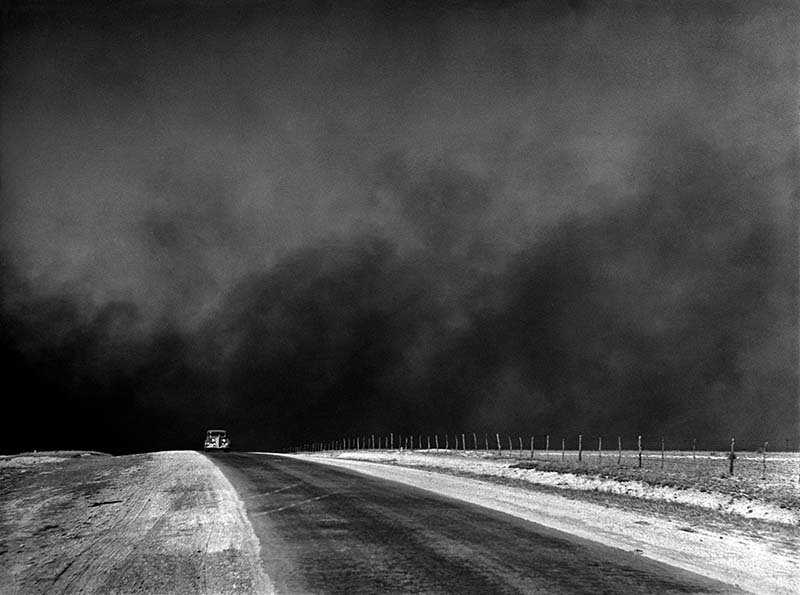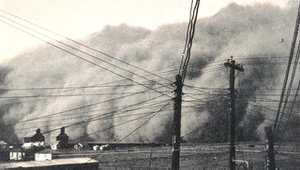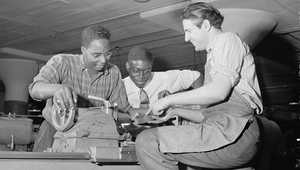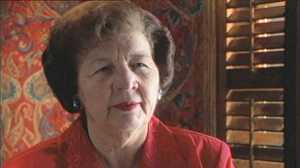Mass Exodus From the Plains
The Dust Bowl prompted the largest migration in American history

When the drought and dust storms showed no signs of letting up, many people abandoned their land. Others would have stayed but were forced out when they lost their land in bank foreclosures. In all, one-quarter of the population left, packing everything they owned into their cars and trucks, and headed west toward California. Although overall three out of four farmers stayed on their land, the mass exodus depleted the population drastically in certain areas. In the rural area outside Boise City, Oklahoma, the population dropped 40% with 1,642 small farmers and their families pulling up stakes.
The Dust Bowl exodus was the largest migration in American history. By 1940, 2.5 million people had moved out of the Plains states; of those, 200,000 moved to California. When they reached the border, they did not receive a warm welcome as described in this 1935 excerpt from Collier’s magazine. “Very erect and primly severe, [a man] addressed the slumped driver of a rolling wreck that screamed from every hinge, bearing and coupling. 'California’s relief rolls are overcrowded now. No use to come farther,’ he cried. The half-collapsed driver ignored him — merely turned his head to be sure his numerous family was still with him. They were so tightly wedged in, that escape was impossible. 'There really is nothing for you here,’ the neat trooperish young man went on. 'Nothing, really nothing.’ And the forlorn man on the moaning car looked at him, dull, emotionless, incredibly weary, and said: 'So? Well, you ought to see what they got where I come from.’ “
The Los Angeles police chief went so far as to send 125 policemen to act as bouncers at the state border, turning away “undesirables”. Called “the bum brigade” by the press and the object of a lawsuit by the American Civil Liberties Union, the LAPD posse was recalled only when the use of city funds for this work was questioned.
Arriving in California, the migrants were faced with a life almost as difficult as the one they had left. Many California farms were corporate-owned. They were larger and more modernized that those of the southern plains, and the crops were unfamiliar. The rolling fields of wheat were replaced by crops of fruit, nuts and vegetables. Like the Joad family in John Steinbeck’s “The Grapes of Wrath”, some 40 percent of migrant farmers wound up in the San Joaquin Valley, picking grapes and cotton. They took up the work of Mexican migrant workers, 120,000 of whom were repatriated during the 1930s. Life for migrant workers was hard. They were paid by the quantity of fruit and cotton picked with earnings ranging from seventy-five cents to $1.25 a day. Out of that, they had to pay twenty-five cents a day to rent a tar-paper shack with no floor or plumbing. In larger ranches, they often had to buy their groceries from a high-priced company store.
The sheer number of migrants camped out, desperate for work, led to scenes such as that described by John Steinbeck in his novel, “The Grapes of Wrath.” “Maybe he needs two hunderd men, so he talks to five hunderd, an’ they tell other folks, an’ when you get to the place, they’s a thousan’ men. This here fella says, “I’m payin’ twenty cents an hour.” An’ maybe half a the men walk off. But they’s still five hunderd that’s so goddamn hungry they’ll work for nothin’ but biscuits. Well, this here fella’s got a contract to pick them peaches or — chop that cotton. You see now? The more fella’s he can get, less he’s gonna pay. An’ he’ll get a fella with kids if he can.”
As roadside camps of poverty-stricken migrants proliferated, growers pressured sheriffs to break them up. Groups of vigilantes beat up migrants, accusing them of being Communists, and burned their shacks to the ground. To help the migrants, Roosevelt’s Farm Security Administration built 13 camps, each temporarily housing 300 families in tents built on wooden platforms. The camps were self-governing communities, and families had to work for their room and board.
When migrants reached California and found that most of the farmland was tied up in large corporate farms, many gave up farming. They set up residence near larger cities in shacktowns called Little Oklahomas or Okievilles on open lots local landowners divided into tiny subplots and sold cheaply for $5 down and $3 in monthly installments. They built their houses from scavenged scraps, and they lived without plumbing and electricity. Polluted water and a lack of trash and waste facilities led to outbreaks of typhoid, malaria, smallpox and tuberculosis.
Over the years, they replaced their shacks with real houses, sending their children to local schools and becoming part of the communities; but they continued to face discrimination when looking for work, and they were called “Okies” and “Arkies” by the locals regardless of where they came from.







